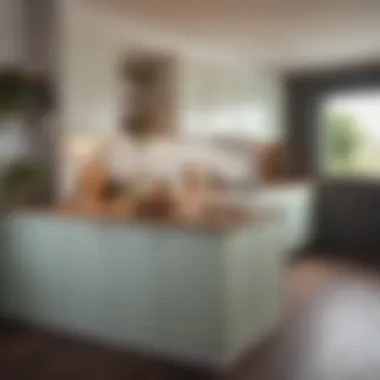Transforming Small Spaces: Your Guide to Kitchen Remodels


Intro
In a world where space becomes a luxury, compact kitchens have emerged as a battleground for creativity, functionality, and style. Whether you’re a homeowner eager to revamp a small cooking area or a renter looking to make subtle upgrades without a full-blown renovation, this guide serves as your trusty companion. We aim to demonstrate how intelligent design principles can transform a compact kitchen into a versatile space that works for you.
Today, more than ever, kitchens have become the heart of the home—where meals are prepared, memories are made, and where life unfolds in a beautifully orchestrated chaos. Nevertheless, compact kitchens often get a bad rap for being cramped or uninspired. This transformation isn’t about changing the shape of the room; it’s about changing how we think about it.
Let’s jump into the key insights and trends of kitchen design for small spaces.
Key Insights and Trends
Current Trends in Interior Design
When it comes to interior design, trends ebb and flow, but in compact kitchens, a few stand out for their sheer utility and visual appeal.
- Bold Colors: Utilizing accent walls in rich colors can define an area without overpowering the space. Think deep greens or muted blues that contrast against lighter cabinetry.
- Open Shelving: This trend provides easy access to frequently used items and adds an airy feel. It’s also an excellent opportunity to display unique dishware or plants.
- Smart Technology: Incorporating smart appliances not only saves space but also enhances efficiency. Devices that sync with smartphones can streamline meal prep and monitoring.
- Multi-functional Furniture: Foldable tables and nests of tables offer versatility, allowing homeowners to adapt their kitchens based on need, whether it’s cooking, dining, or entertaining.
Popular Gardening Techniques of the Season
While the kitchen is where meals are prepared, many compact kitchens are also incorporating mini-gardens, a growing trend that emphasizes sustainability and freshness.
- Herb Gardens: Consider using wall-mounted planters to grow herbs like basil and cilantro. This brings life to your kitchen and ensures you have fresh ingredients at hand.
- Vertical Gardens: For those short on counter space, vertical gardening offers a stylish way to include greenery without taking up much room.
- Succulents and Air Plants: These low-maintenance plants complement the kitchen aesthetics while surviving in less-than-ideal sunlight. Their minimal water needs make them the perfect addition.
Practical Tips and How-To Guides
So, now that we’ve explored the trends, it’s time to delve into practical aspects. Here, you’ll find vital tips and a straightforward guide to tackle your compact kitchen remodel efficiently.
Step-by-step Guides for Home Decoration Projects
- Assess Your Space: Take exact measurements. Know where doors, windows, and outlets are located. An inadequate fit can lead to frustration.
- Create a Vision Board: Gather inspiration from online resources, magazines, or even Pinterest. Visualizing your ideal space can clarify choices.
- Choose a Focal Point: Focus on one area, like a bold backsplash or statement light fixture, to draw attention and add character.
- Maximize Storage: When space is limited, think vertically. Use cabinets that reach the ceiling; consider under-sink organizers and pull-out drawers for pots and pans.
Entertaining Tips and Planning Checklists
- Opt for Portable Furniture: If your compact kitchen could use more seating, perhaps consider movable bar stools or folding seating that can be easily stored away.
- Create an Open Flow: Use furniture placements to ensure easy movement. Cluttering pathways sends your guests knocking into things, which is a surefire way to ruin the ambiance.
- Plan Your Menu Around the Space: When entertaining, think simple yet elegant dishes that require minimal prep space. Dishes that can be served on single platters allow for more socializing and less scrambling.
Having a well-planned kitchen reflects not just your style but your efficiency as a host. Less clutter means more memory making—both in cooking and entertaining.
By diving into each facet of compact kitchen remodels, we unravel the secrets to maximizing both form and function. Let’s tiptoe through the details that can spark the transformation your compact kitchen deserves.
Understanding the Compact Kitchen Concept
Remodeling a compact kitchen isn't just about reducing square footage; it's about embracing an entirely new philosophy of space utilization. When one grasps the concept of compact kitchens, it becomes clear that every inch matters. The charm of these spaces lies in their ability to blend functionality and aesthetics without sacrificing personal style. As urban living becomes more prevalent, understanding the compact kitchen concept offers insights into making our homes more livable and organized, accommodating our lifestyles in a seamless manner.
Defining Compact Kitchens
A compact kitchen typically refers to a small, efficiently designed cooking area that maximizes functionality without compromising style. These kitchens may range from galley layouts to L-shaped designs, often featuring essential appliances and cleverly integrated storage solutions. The real essence of a compact kitchen is its adaptability – transforming a limited space into a culinary haven. Think of it as a puzzle, where each piece, from the cabinets to the countertops, must work in harmony.
Listeners often associate compact kitchens with cramped environments, but that doesn't have to be the case. With smart design choices, a compact kitchen can serve as both a cozy cooking zone and a friendly gathering spot.
The Importance of Functional Spaces
In any successful remodel, functionality reigns supreme. A compact kitchen must be a space where every task – from meal prep to clean-up – flows smoothly. Consider how a well-planned kitchen can simplify everyday routines. For instance, integrating an open shelving design not only saves space but also promotes accessibility, allowing for a sleek look that makes cooking more intuitive.
"A well-designed kitchen can transform how we interact in our homes, emphasizing efficiency while encouraging enjoyment of the cooking experience."
When planning a remodel, focus on areas such as ease of movement and accessibility. Ensure that commonly used items are within arm's reach, minimizing unnecessary steps. This not only boosts productivity but also fosters a sense of comfort.
Key points to consider:
- Efficient layouts: Prioritize kitchen triangles, which include the stove, sink, and refrigerator.
- Quality over quantity: Invest in versatile appliances that offer multiple functions.
- Zoning: Create distinct areas for cooking, assembling, and cleaning to maintain fluidity.
Planning Your Remodel
When it comes to compact kitchen remodels, planning is everything. It's the cornerstone that upholds the entire project. A well-structured plan not only guides your decisions but also saves time and money down the line. The process of remodeling a small space can be daunting, but a thought-out strategy can make it as smooth as silk. This phase is about more than just envisioning a beautiful outcome. It's about gaining an understanding of your current kitchen layout, setting financial boundaries, and devising a reasonable timeline.
Assessing Your Current Space
To kick things off, take a good, hard look at your existing kitchen. It’s easy to jump straight into the aesthetics, but functionality reigns supreme in a compact kitchen. Start by measuring every inch of the space—walls, windows, appliances. Having an accurate understanding of your dimensions is like having a treasure map before the expedition.
Consider how you use your kitchen daily. Is it a cramped cooking nook, or does it also double as a family gathering spot? Pay attention to your workflow: the classic kitchen triangle (sink, stove, refrigerator) should still apply, even in smaller spaces. It might help to sketch out your current layout and make notes about what works and what drives you up the wall. By identifying your pain points, you can make informed choices about what to improve.
Setting a Realistic Budget
Next on the agenda—money. Setting a realistic budget is crucial and can often feel like trying to fit an elephant into a Smart car, but it’s essential to keep your finance in check to avoid those pesky regrets later on. Begin by determining how much you can allocate to the project. Think about materials, labor, and a contingency fund for those little surprises that tend to pop up like weeds in a garden.
It’s useful to break down costs into categories:
- Materials: Cabinets, countertops, flooring, etc.
- Appliances: Don’t skimp here; go for energy-efficient options.
- Labor: Whether it’s hiring professionals or doing it yourself, consider who’s managing what.
- Contingency Fund: Aim for around 10% of your total budget.
This way, if an unexpected issue arises, like a leaky pipe or structural woes, you won’t end up in hot water financially.


Establishing a Timeline
Now, with your space assessed and budget set, it’s time to create a timeline. Launching a remodeling project often comes with an overwhelming sense of urgency, but patience is key here. Rushing to finish can compromise the quality and functionality of your new kitchen.
Start by breaking your remodel down into phases, such as:
- Design and Planning: Draft layouts and finalize your design choices.
- Demolition: Clear out the old to make way for the new.
- Construction: Begin installation of cabinetry and new appliances.
- Finishing Touches: Paint, backsplash, and your personal flair.
A well-paced timeline sets expectations and gives you room to breathe. Try communicating estimated durations for each phase to everyone involved, so there are no surprises along the way.
"If you don't know where you're going, you'll end up somewhere else." – Yogi Berra
In the end, planning your remodel might seem like a cumbersome initial step, but it paves the way for a kitchen that not only looks good but works well in your everyday life. By thoughtfully assessing your space, adhering to a budget, and sticking to a timeline, you'll set the stage for a successful compact kitchen transformation.
Design Principles for Small Kitchens
Designing a compact kitchen involves a careful balance of aesthetics and functionality. Every square inch matters, and this is where thoughtfulness transforms a constrained environment into a well-oiled machine. Strong design principles help to enhance efficiency without sacrificing style. When faced with limited space, the way you approach design can dramatically affect usability.
Maximizing Vertical Space
In a compact kitchen, vertical space is often the unsung hero. Utilizing wall-mounted shelves, cabinets extending up to the ceiling, and pegboards keeps the clutter at bay while offering storage solutions. For example, open shelving offers not just practicality but also the chance to showcase beautiful dishware or culinary tools, making your kitchen visually appealing. Consider adding magnetic strips to hold knives or spices; it saves counter space and adds a modern feel.
By looking up rather than just across, you can expand your storage options significantly. Hanging pot racks are another choice, making pots and pans accessible while contributing warmth to the room’s aesthetic. Every shelf and rack should serve a purpose, ensuring that no space is wasted.
Selecting Appropriate Color Schemes
The colors chosen for your kitchen can radically influence its perceived size. Light hues, like creams and soft whites, can create an illusion of openness. On the flip side, bold accents or darker shades can add depth and interest, drawing attention to features you wish to highlight.
Think of it this way: A light-colored backsplash can reflect light, making the area appear airy. Alternatively, painting a single wall a deep hue can add character without overwhelming the space. The use of complementary colors between cabinets and walls can unify your design, creating a seamless flow.
- Consider using:
- Pastel colors for a light, inviting feel.
- Earth tones to enrich a warm aesthetic.
- Bright colors for an eye-catching feature.
When in doubt, test how different colors appear under various lighting throughout the day. Subtle changes can lead to vastly different experiences in your compact kitchen.
Creating an Open Layout
An open kitchen layout caters to modern living, particularly in compact spaces. Eschewing barriers between the kitchen and adjoining areas encourages interaction, making the kitchen a central hub for family and friends. Consider using an island as both a cooking and dining space, or opt for a breakfast bar that can double as preparation space.
Open layouts often create a sense of flow. When designing, think of how you move through the space and access different areas.
A few tips to achieve an open layout include:
- Removing unnecessary walls where feasible.
- Using furniture that is multi-functional, like stools that tuck under an island.
- Choosing glass doors or open shelving to maintain visibility.
Ultimately, the goal of an open layout is to foster a communal atmosphere and ease of movement, both vital in a smaller kitchen setting.
"In small kitchens, every inch counts—make sure they’re working for you, not against you."
By embracing these design principles, your compact kitchen can become a space that not only meets daily needs but also reflects your personal style.
Storage Solutions
Storage solutions play a pivotal role in the design and functionality of compact kitchens. In smaller spaces, every inch counts, making it crucial to adopt strategies that not only provide ample storage but also maintain an organized layout. Effective storage solutions can transform a cluttered kitchen into a serene cooking environment where everything has its place.
When designing a compact kitchen, consider some specific elements to maximize your space:
- Accessibility: Easy access to tools and ingredients helps streamline cooking processes and creates an efficient workflow.
- Organization: Clever solutions can prevent crowded countertops and closed-off cabinets, enabling a clean and orderly appearance.
- Aesthetics: Well-thought-out storage choices can also contribute to the overall look of the kitchen, reflecting your personal style while enhancing the space.
The benefits of maximizing storage in compact kitchens are numerous. You increase practicality, and decrease the visual chaos, enhancing the kitchen experience.
Smart Cabinetry Options
Selecting smart cabinetry is essential for compact kitchens. Instead of traditional cabinets, think beyond the box. Base cabinets can offer pull-out shelves or lazy Susans, allowing for efficient organization. Soft-close drawers with dividers for utensils can keep everything at your fingertips without sacrificing order. Another smart option is integrating cabinetry that extends up to the ceiling. This not only utilizes the entire vertical space but also offers an extra layer of storage for things you seldom need — think less-used appliances or holiday dishes.
Utilizing Drawers and Shelves
Drawers and shelves serve a dual purpose: providing storage and aiding organization. Ensure that drawers are deep enough to hold pots, pans, and extra kitchen gadgets without being cumbersome.
Consider these strategies:
- Stacking Shelves: In areas not used for cooking, such as the entry to the kitchen, stack shelves to hold cookbooks, plants, or decorative containers. This draws the eye upward, enhancing the room's perception of height.
- Open Shelving: Using open shelves encourages a decorative display while remaining functional. Use attractive storage jars or showcase spices to bring color into the area.
Incorporating Multi-Functional Furniture
When it comes to furniture in compact kitchens, multi-functional pieces can be a real game changer. Think about incorporating an island that not only serves as a prep surface but also has built-in storage for pans and utensils. A dining table that doubles as a workspace can eliminate the need for excess furniture, maintaining a clean design.
The beauty of multi-functional furniture is its ability to adapt to daily needs. A drop-leaf table provides flexibility; you can expand it during meal times and tuck it back when you want more space around.
"Utilizing every nook and cranny ensures that you create a kitchen that’s not just stylish but also immensely practical."


In summary, optimizing storage solutions in compact kitchens requires creativity and a thoughtful approach. Smart cabinetry, strategic use of drawers and shelves, along with multifunctional furniture can create an environment where everything has its place, improving functionality without sacrificing style.
Choosing Materials and Appliances
In any compact kitchen remodel, the choice of materials and appliances plays a crucial role in determining both functionality and aesthetics. With limited space, selecting the right materials not only impacts the kitchen's durability but also its style. Wise choices can elevate the ambiance while ensuring that the kitchen operates efficiently throughout daily culinary activities.
When diving into the aspect of materials, consider the resilience, maintenance needs, and visual appeal. The kitchen often endures heat, moisture, and spills, making it essential to choose materials that can withstand these challenges.
Selecting Durable Countertops
Countertops are arguably one of the most visible components of a kitchen. They become the heart of the cooking and gathering space. Thus, selecting durable countertops is about striking a balance between resilience, maintenance, and style.
- Material Options: There are several materials available, including granite, quartz, and butcher block. Each offers unique advantages. For instance, granite is known for its toughness and resistance to scratching and heat. Quartz, being engineered, is often non-porous, making it more resistant to stains, which can be handy in a busy kitchen. However, butcher block brings warmth and a traditional touch, but it requires more upkeep to prevent it from warping or staining.
- Longevity vs. Cost: While durable materials might come at a higher upfront cost, they often save money in the long run due to reduced maintenance and replacement needs. Investing in quality materials means that homeowners might avoid costly repairs or replacements several years down the line.
- Design Compatibility: The colors and patterns of the countertop should align with the overall design of the kitchen. For example, a sleek, minimalist approach might favor a solid color quartz, while a rustic theme could harness the charm of a natural stone.
"A countertop isn’t just a surface; it's the stage where culinary magic happens, so choose wisely!"
Energy-Efficient Appliances
In a compact kitchen, appliances should not only be functional but also efficient to conserve space and energy. The modern homeowner is often looking for appliances that optimize performance while minimizing their carbon footprint.
- Benefits of Energy Efficiency: Energy Star-rated appliances are designed to use less energy than standard versions. Investing in these not only reduces utility bills but also contributes to environmental responsibility. In densely populated areas, these savings can make a noticeable difference over time.
- Space-Saving Designs: Compact appliances are increasingly available for those looking to remodel smaller kitchens. Think slim refrigerators or combination microwave-ovens that can save precious counter space. Such options ensure that one doesn't sacrifice functionality amid size constraints.
- Smart Technology: Many new appliances incorporate smart technology, allowing users to control them remotely or monitor energy usage. This technology can alert homeowners if appliances are left running too long or if energy consumption is higher than normal, promoting a more efficient household.
Lighting Considerations
When it comes to compact kitchen remodels, lighting plays a pivotal role. It’s not merely about illumination; rather, the right lighting elevates the ambiance, creates depth, and enhances functionality in a tight space. Well-thought-out lighting can make a cramped area feel more open and visually appealing. One cannot overstate the importance of proper lighting, especially in a kitchen where safety, efficiency, and aesthetics converge.
Layering Different Types of Lighting
For any small kitchen remodel, employing a layered lighting approach is essential. This style comprises three main categories: ambient, task, and accent lighting.
- Ambient Lighting: This is the main source of light in your kitchen, often provided by ceiling-mounted fixtures such as flush mounts or chandeliers. It casts a general glow across the room, ensuring that every corner is adequately lit.
- Task Lighting: This specific light aids in completing kitchen tasks, illuminating areas such as countertops or the sink—where chopping vegetables or washing dishes takes place. Strategically placed under-cabinet lights are fantastic for this purpose, as they provide direct light where you need it most.
- Accent Lighting: Adding flair to your kitchen’s aesthetics, accent lighting highlights unique features like artwork, shelves, or architectural details. This can be achieved through spotlights, wall sconces, or LED strips that draw attention to specific areas.
Layering these types ensures that you get comprehensive lighting coverage. It not only enhances functionality but also contributes to the overall design of the kitchen. By combining these layers, you create a well-lit space that feels inviting and stylish.
Using Task Lighting Effectively
Task lighting is not just a functional aspect; it’s the unsung hero of kitchen designs. Proper task lighting reduces eye strain, enhances safety, and helps maintain a tidy kitchen. In a compact kitchen, effective placement can make all the difference.
- Under-Cabinet Lights: These fixtures are optimal for illuminating countertops. Consider LED strips as they are energy-efficient and can be installed discreetly.
- Pendant Lights: If you have an island, hanging pendant lights above it can create a focused area for meal prep or casual dining. Opt for fixtures that complement your kitchen’s style.
- Directional Spotlights: These work well in small spaces. By directing light to specific areas, they eliminate shadowy spots around your cooking space.
Efficiency is key. The better your task lighting, the more enjoyable the cooking experience. Do not forget to consider dimmable options as well. Having the ability to adjust the intensity can create a cozy vibe when desired.
"Good lighting can make a small kitchen feel grand and open, blending aesthetics with practicality seamlessly."
When embarking on the journey of a compact kitchen remodel, don’t sidestep the power of lighting. Layer your sources properly, implement task-specific options wisely, and you create not just an efficient workspace but also a kitchen that you would be delighted to show off.
Incorporating Technology
In today's world, technology is no longer an optional extra; it's a must-have in our kitchens, especially when space is tight. Incorporating technology into a compact kitchen remodel can revolutionize how the space is used and enhance functionality without sacrificing style. From smart appliances to apps that streamline our cooking experiences, the advantages of leveraging technology are manifold.
Smart Kitchen Gadgets
When it comes to smart kitchen gadgets, it’s like having a little helper right at your fingertips. These tools not only save time but also do a beautiful job in optimizing limited space. Consider gadgets like the Instant Pot or a compact air fryer. Both products have gained traction for their versatility. The Instant Pot, for instance, can pressure cook, steam, slow cook, and even sauté—all in one unit. This means you don’t have to fill your cupboards with a slew of appliances, reducing clutter.
Other gadgets worth considering include:
- Smart refrigerators that keep track of your groceries, alerting you when you’re running low on essentials.
- Smart kitchen scales that can help with precise measurements, perfect for the baking enthusiasts.
- Voice-activated assistants that can set timers or look up recipes while your hands are full with food preparation.
By adopting smart kitchen gadgets, homeowners not only enhance their cooking efficiency but also add a modern touch to the kitchen's aesthetic.
Utilizing Apps for Space Management
Apps are becoming essential in managing and reorganizing kitchen spaces, particularly when you are facing space constraints. They help in planning layouts and managing inventories with a few taps on your phone. Take, for example, apps like "MagicPlan" that enable you to measure your kitchen and create a digital blueprint. This can assist immensely in visualizing how different elements will fit together.
Another useful app is "Paprika," which assists in meal planning and recipe organization. It allows users to categorize and search for recipes easily, which is invaluable when space is a premium and appliances need to be well-integrated into workflows.
The benefits of using such apps include:
- Organizational efficiency: Keeping track of what you have in stock can reduce waste and keep meals varied and exciting.
- Visualization: By mapping out your kitchen digitally, you can make informed decisions on what to add and where.
- Time-saving: Quick access to favorite recipes means less time spent rummaging through cookbooks or searching online.
Incorporating technology into your compact kitchen remodel isn't just about filling the space with gadgets; it’s a holistic approach to creating a functional and efficient environment. As your awareness of these tools grows, your compact kitchen can transform into a place where tech complements tradition, making cooking not only simpler but enjoyable.
Personalizing Your Space
Bringing a touch of yourself into your compact kitchen isn’t just about aesthetics. It's a way of enhancing your everyday life in such a small yet vital space. Personalizing a kitchen can transform it from just a work area to a welcoming environment that reflects your personality and lifestyle. For many, the kitchen is the heart of the home. It’s where meals come to life, conversations unfold, and memories are created. Hence, personalizing this space is crucial not only for functionality but also for fostering comfort and warmth.
Choosing Complementary écor
When it comes to decor, it’s not just about selecting items that look nice, but rather choosing pieces that harmonize with your kitchen's style and your personal taste.


- Color Palette: Use colors that resonate with you while considering the overall theme of your kitchen. For example, if you lean towards a rustic vibe, muted earth tones or deep greens and browns might be your go-to options.
- Material Choices: Various materials can evoke different feelings. Wood, for instance, often brings warmth. In contrast, metal accents can give a sleek, modern touch. Mixing and matching can be appealing, but ensure that it flows cohesively.
- Accessorizing Wisely: Select kitchen accessories, like dishware or utensils, that are not just functional but also express who you are. Consider patterns or designs that evoke a particular vibe — maybe floral prints for a vintage look or minimalist styles for a more contemporary feel.
- Plants for Life: Adding greenery can do wonders. Choose small herb pots or hanging planters to not only beautify the kitchen but also introduce natural freshness and even functionality, should you use fresh herbs in your cooking.
Art and Finishing Touches
Incorporating art and those finishing touches can greatly influence the final look and feel of your kitchen. Think of your space as a canvas, ready to be adorned with elements that narrate your story:
- Artwork: Select pieces that resonate with you personally. This could be framed family recipes passed down generations or prints from local artists that inspire you. Try hanging them at eye level to create visual interest.
- Functional Art: Items like beautifully designed canisters, jars, or bowls can serve dual purposes. Not only do they hold items, but they also act as decorative elements when displayed.
- Lighting Fixtures: Creative light fixtures can act not just as functionality but as art pieces themselves. Consider something bold that stands out or is something that complements the theme of your kitchen.
Integrating personal touches not only enhances the aesthetics but can also boost your mood while spending time in the kitchen.
Important Note: Don’t hesitate to make changes as you evolve. A kitchen should grow with you, adapting to the changing tastes and requirements over time.
Common Mistakes to Avoid
When embarking on a compact kitchen remodel, it’s important to be aware of common pitfalls that can turn your transformation from a dream into a nightmare. Understanding these mistakes can save you time, money, and a lot of headaches down the line. It's not just about making your kitchen look good; functionality is key. Let’s break down some of the frequent errors that people tend to overlook and how to dodge them.
Overlooking Functionality
At first glance, beauty can captivate anyone. Yet, if you overlook functionality, your kitchen might turn problematic sooner than you'd like. Imagine a sleek, attractive kitchen that looks stunning but lacks enough counter space to actually work on. You might find that a fancy island just takes up needed square footage without serving a real purpose.
To strike the right balance, consider these functional aspects:
- Workspace: Ensure there’s enough surface space for meal prep without constant rearranging. A butcher block can double as a cutting space and a dining area.
- Appliance Size: Choose appliances that fit your needs rather than settling for the latest trend. A large fridge may dominate the space with little utility, especially if you're short on storage.
- Storage Solutions: Custom cabinetry can maximize space. Use pull-out shelves, corner cabinets that twist out, or even under-the-sink storage bins. Super important—don’t forget about vertical storage, too!
Planning your kitchen around these insights will help you create a space that’s practical as well as beautiful. This approach allows you to cook, entertain, and even host gatherings without constantly battling against space limitations.
Ignoring Flow and Accessibility
Now, this one’s a biggie. Your kitchen should never be a maze; it ought to have a natural flow. If you enter your kitchen and feel like you’re doing The Twist just to grab a spice, something is most likely off. Ignoring flow can make what should be an enjoyable space feel like a chore.
To foster a smooth layout:
- Work Triangle: Keep the classic work triangle in mind (the distance between the sink, stove, and fridge). A compact kitchen often means adjusting these elements to make sure they are not too far apart.
- Clear Pathways: Avoid cramming too much furniture or appliances in small areas. Keep at least 36 inches of aisle space to allow several people to move about comfortably.
- Personal Accessibility: Consider who uses your kitchen the most—are there kids or elderly family members? A pull-out drawer for pots might be more effective than a high shelf.
Effective flow in the kitchen is not just a convenience; it can significantly enhance your cooking experience.
Prioritizing functionality and flow will lead to a compact kitchen that welcomes everyone to enjoy. By steering clear of these common missteps, your kitchen remodel can shine and serve its purpose brilliantly.
Consulting with Professionals
When embarking on a compact kitchen remodel, seeking professional guidance can be a game changer. Many homeowners underestimate the complexities involved in designing and executing a remodel, especially within confined spaces. Consulting with professionals not only brings expertise but also opens up a wealth of resources that can turn your vision into reality. Here are some specific reasons why consulting with a designer or contractor is beneficial:
- Expertise in Small Spaces: Professionals understand the nuances of designing compact kitchens. They can provide tailored solutions that maximize functionality without compromising on style.
- Access to Resources: Designers and contractors often have access to materials, appliances, and fixtures that may not be readily available to the general public. This can elevate the quality of your remodel significantly.
- Time Management: Professionals bring experience that can expedite the project timeline. This efficiency is crucial when you're working within the constraints of a small space.
- Troubleshooting Skills: Remodeling often involves unforeseen challenges. Having a professional at your side means that they can handle any surprises with expertise and poise.
In short, enlisting the help of knowledgeable individuals can mitigate costly mistakes and lead to a smoother remodeling process. This way, your compact kitchen can become a masterpiece of design and utility.
When to Hire a Designer
Deciding when to bring a designer into your kitchen remodeling project depends on a few factors. Here are some situations where hiring a designer makes perfect sense:
- Complex Designs: If your kitchen has complicated layouts or structural limitations, a designer can provide insights that enhance functionality while hiding any design flaws.
- Unique Aesthetic Vision: When you have a specific look in mind but aren't sure how to achieve it in a small space, a designer can guide you toward practical applications of your ideas.
- Budget Management: Designers can help you allocate your budget effectively, ensuring that every dollar is spent wisely. They have the experience to suggest areas where you could save without sacrificing quality.
"Investing in a designer can save you more in the long run by preventing costly errors."
Finding the Right Contractor
Finding a reliable contractor is as crucial as selecting a designer. Here are key points to consider when choosing the right contractor for your compact kitchen remodel:
- Credentials and Experience: Check qualifications and previous work. A seasoned contractor will have a good portfolio showcasing their expertise in small spaces.
- Local Reputation: Look for reviews and testimonials in your area. Engaging with local community boards or social media groups can yield valuable insights and recommendations.
- Clear Communication: Choose someone who listens to your ideas and communicates effectively. The remodeling process can be stressful, and you want a contractor who keeps you in the loop.
- Detailed Estimates: A good contractor should provide a detailed estimate outlining costs, timelines, and materials involved. This transparency can help prevent surprises down the road.
- Contract Agreement: Once you choose a contractor, ensure that everything is captured in a formal contract. This document should cover all aspects of the project, from start date to payment terms.
Taking the time to find the right professionals for your kitchen remodel will not only make your life easier, but it will also ensure that the end result is a stunning and functional space you can enjoy for years to come.
Case Studies and Inspiration
Understanding how an effective remodel has worked for others can provide a well of ideas and motivation. Case studies and inspiration play a crucial role in this guide. By looking at real-life transformations, you gain insights not just into aesthetics but also practical implementation. You see how others tackled space constraints, made design choices, and cleverly utilized materials. This firsthand knowledge can guide your own decisions, ensuring you avoid pitfalls and harness what works.
Successful Compact Kitchen Transformations
In compact kitchens, every inch counts. A striking example comes from a couple in San Francisco who turned their 200-square-foot kitchen into a culinary haven. They began with an outdated layout that felt cramped and inefficient. After consulting with a designer, they opted for a modern minimalist approach, emphasizing open shelving instead of bulky cabinets. This choice visually expanded their space, creating an airy feel.
They also installed a fold-out dining table, providing a multifunctional area for both cooking and dining. The result was not just a kitchen but a vibrant heart of the home where they host dinners and gatherings. Their story is a reminder that functionality can live hand in hand with style.
Another inspiring case is that of an urban renter who revitalized a narrow galley kitchen in New York City. Recognizing her limited budget, she focused on DIY projects. With a bit of paint and some clever use of adhesive wall-mounted racks, she created a fresh and inviting atmosphere.
Moreover, she incorporated a compact dishwasher that fit under her countertop, a smart choice for maintaining cleanliness without losing precious space. Seeing such transformations fuels the imagination, showing that with some creativity, even the most challenging layouts can become stunning and functional spaces.
Before and After Comparisons
Before you start your remodel, it’s insightful to examine before and after comparisons. These visual guides can provide a fresh perspective on potential outcomes, allowing you to envision what’s possible. Take a kitchen remodel in a small townhouse as a case point. Originally, it was plagued by dark cabinets, a cramped layout, and outdated appliances. The transformation was remarkable:
- Before: Outdated and dark, felt like cooking in a cave.
- After: Light, bright space with a modern touch and open plan.
To achieve this, the homeowners chose lighter colors and introduced elements like glass front cabinets. They also swapped out conventional countertops with durable quartz, giving a polished yet welcoming feel.
Such before and after stories can serve as a yardstick against which you can measure your potential design. They crystallize the journey of transformation, shedding light on what specific changes made the most significant differences.
Ultimately, these case studies not only serve as inspiration but also anchor your remodeling process in reality. They underline the fact that thoughtful planning and execution can transform a cramped cooking space into a culinary oasis.



